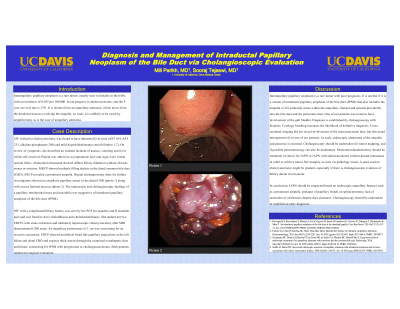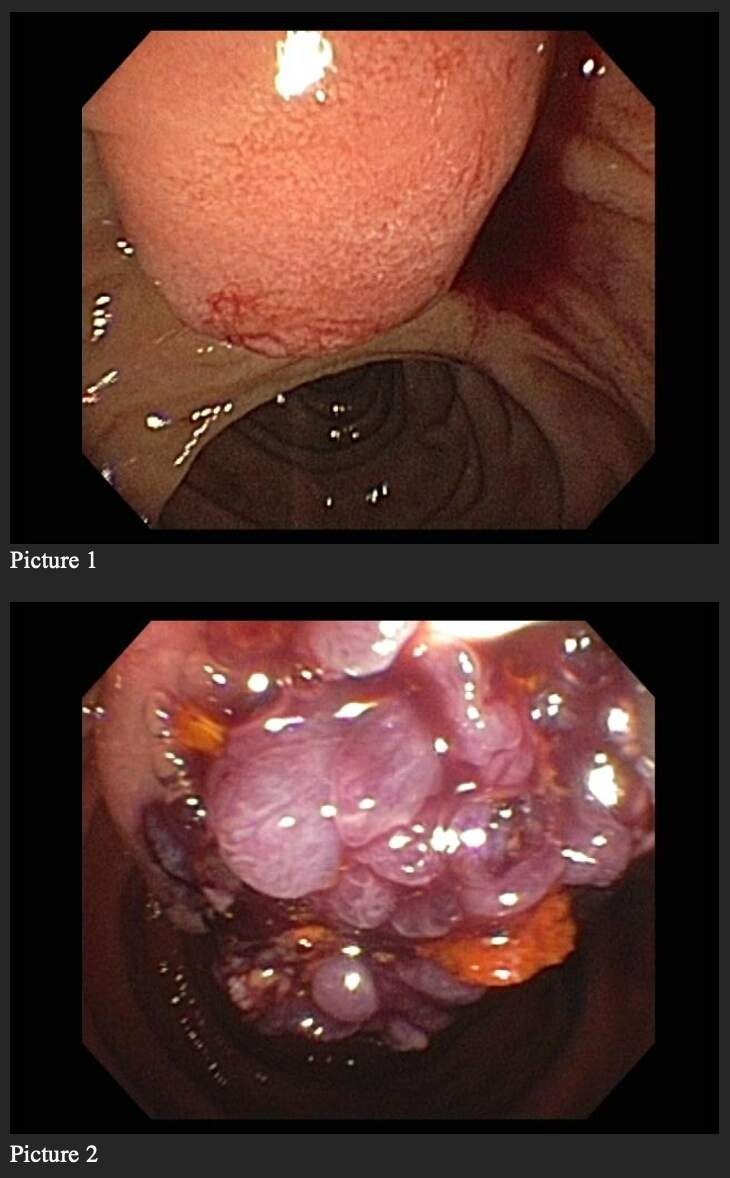Back


Poster Session C - Monday Afternoon
Category: Biliary/Pancreas
C0067 - Diagnosis and Management of Intraductal Papillary Neoplasm of the Bile Duct via Endoscopic Ultrasound Evaluation
Monday, October 24, 2022
3:00 PM – 5:00 PM ET
Location: Crown Ballroom

Has Audio

Mili Parikh, MD
UC Davis Medical Center
Sacramento, CA
Presenting Author(s)
Mili Parikh, MD, Sooraj Tejaswi, MD
UC Davis Medical Center, Sacramento, CA
Introduction: Intrampullary papillary neoplasm (IAPN) is a rare tumor seen in women in their 60s, with an incidence of 0.025 per 100,000. The 5-year survival rate is 33%. It is distinct from an ampullary adenoma, which arises from the duodenal mucosa overlying the ampulla. It is unlikely to be cured by ampullectomy.
Case Description/Methods: 63F with prior cholecystectomy was found to have abnormal liver tests (AST 104, AST 233, alkaline phosphatase 290) and mild hyperbilirubinemia (total bilirubin 1.7). Abdominal ultrasound showed diffuse biliary dilatation without obvious stones or stricture. MRCP showed multiple filling defects in the distal common bile duct (CBD). ERCP revealed a prominent ampulla. Digital cholangioscopy done for further investigation showed an exophytic papillary tumor in the distal CBD (photo 1) along with excess luminal mucous (photo 2). The endoscopic and cholangioscopic findings of a papillary intraluminal mass and mucobilia was suggestive of intraductal papillary neoplasm of the bile duct (IPNB).
69F with a complicated biliary history was seen by her PCP for jaundice and R shoulder pain and was found to have cholelithiasis and choledocholithiasis. She underwent laparoscopic cholecystectomy after MRI showed CBD stones. An ampullary prominence of 1 cm was concerning for an invasive carcinoma. ERCP showed multifocal frond like papillary projections at the left hilum and distal CBD and copious thick mucin through the examined extrahepatic duct and hilum; concerning for IPNB with progression to cholangiocarcinoma. Both patients underwent surgical evaluation.
Discussion: IAPN is a rare tumor with poor prognosis. It is unclear if it is a variant of IPNB that also includes the ampulla or if it primarily arises within the ampullary channel and spreads proximally into the bile duct and the pancreatic duct. Diagnosis is established by cholangioscopy with biopsies. Endoscopic ultrasound of the ampulla and pancreas is essential. Cholangioscopy should be undertaken for tumor mapping. Pancreaticoduodenectomy should be treatment of choice for IAPN or IAPN with adenocarcinoma without distant metastases in order to achieve tumor free margins, as seen via pathology tissue.
IAPN should be suspected based on endoscopic ampullary features such as a prominent ampulla, prolapse of papillary fronds on sphincterotomy, lack of resolution of cholestasis despite duct clearance. Cholangioscopy should be undertaken establish an early diagnosis.

Disclosures:
Mili Parikh, MD, Sooraj Tejaswi, MD. C0067 - Diagnosis and Management of Intraductal Papillary Neoplasm of the Bile Duct via Endoscopic Ultrasound Evaluation, ACG 2022 Annual Scientific Meeting Abstracts. Charlotte, NC: American College of Gastroenterology.
UC Davis Medical Center, Sacramento, CA
Introduction: Intrampullary papillary neoplasm (IAPN) is a rare tumor seen in women in their 60s, with an incidence of 0.025 per 100,000. The 5-year survival rate is 33%. It is distinct from an ampullary adenoma, which arises from the duodenal mucosa overlying the ampulla. It is unlikely to be cured by ampullectomy.
Case Description/Methods: 63F with prior cholecystectomy was found to have abnormal liver tests (AST 104, AST 233, alkaline phosphatase 290) and mild hyperbilirubinemia (total bilirubin 1.7). Abdominal ultrasound showed diffuse biliary dilatation without obvious stones or stricture. MRCP showed multiple filling defects in the distal common bile duct (CBD). ERCP revealed a prominent ampulla. Digital cholangioscopy done for further investigation showed an exophytic papillary tumor in the distal CBD (photo 1) along with excess luminal mucous (photo 2). The endoscopic and cholangioscopic findings of a papillary intraluminal mass and mucobilia was suggestive of intraductal papillary neoplasm of the bile duct (IPNB).
69F with a complicated biliary history was seen by her PCP for jaundice and R shoulder pain and was found to have cholelithiasis and choledocholithiasis. She underwent laparoscopic cholecystectomy after MRI showed CBD stones. An ampullary prominence of 1 cm was concerning for an invasive carcinoma. ERCP showed multifocal frond like papillary projections at the left hilum and distal CBD and copious thick mucin through the examined extrahepatic duct and hilum; concerning for IPNB with progression to cholangiocarcinoma. Both patients underwent surgical evaluation.
Discussion: IAPN is a rare tumor with poor prognosis. It is unclear if it is a variant of IPNB that also includes the ampulla or if it primarily arises within the ampullary channel and spreads proximally into the bile duct and the pancreatic duct. Diagnosis is established by cholangioscopy with biopsies. Endoscopic ultrasound of the ampulla and pancreas is essential. Cholangioscopy should be undertaken for tumor mapping. Pancreaticoduodenectomy should be treatment of choice for IAPN or IAPN with adenocarcinoma without distant metastases in order to achieve tumor free margins, as seen via pathology tissue.
IAPN should be suspected based on endoscopic ampullary features such as a prominent ampulla, prolapse of papillary fronds on sphincterotomy, lack of resolution of cholestasis despite duct clearance. Cholangioscopy should be undertaken establish an early diagnosis.

Figure: Photo 1 and Photo 2
Disclosures:
Mili Parikh indicated no relevant financial relationships.
Sooraj Tejaswi indicated no relevant financial relationships.
Mili Parikh, MD, Sooraj Tejaswi, MD. C0067 - Diagnosis and Management of Intraductal Papillary Neoplasm of the Bile Duct via Endoscopic Ultrasound Evaluation, ACG 2022 Annual Scientific Meeting Abstracts. Charlotte, NC: American College of Gastroenterology.
